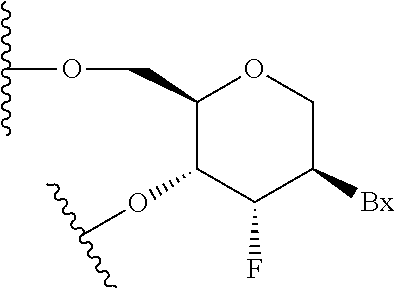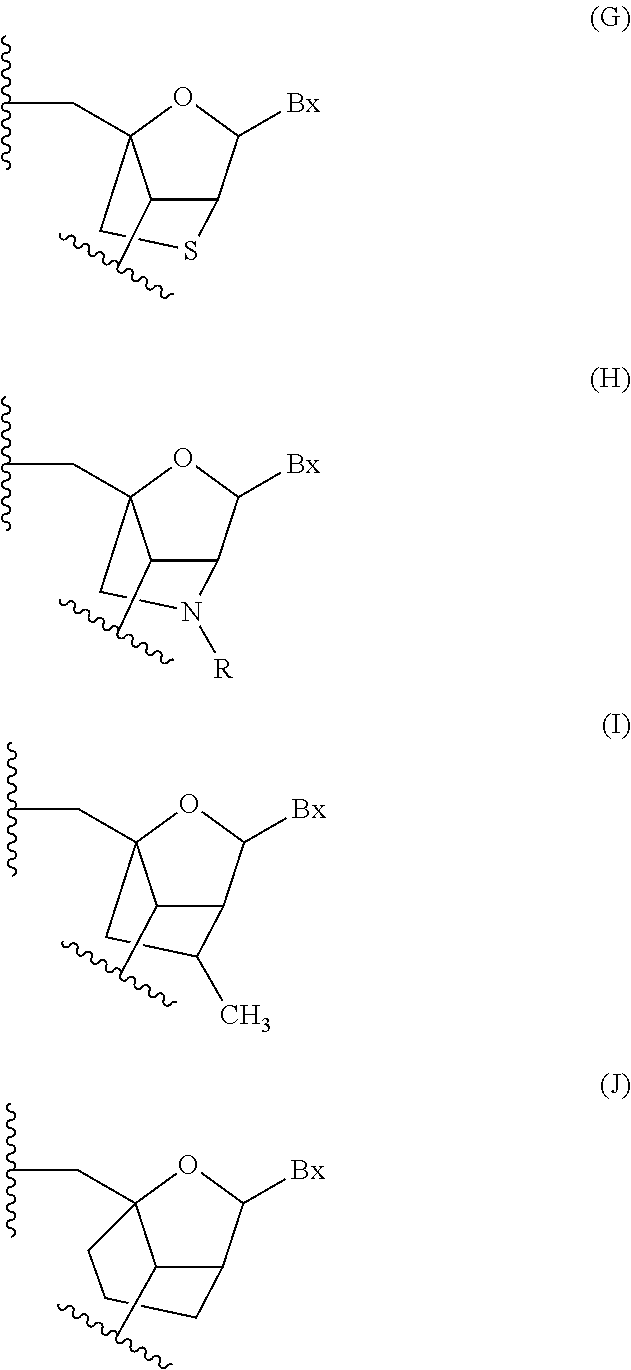Modulation of angiopoietin-like 3 expression
a technology of angiopoietin and expression, applied in the field of reducing the expression of angiopoietinlike 3 (angptl3) mrna, can solve the problems of inability to accept treatment options for cardiovascular and metabolic disorders, inducing weight gain, etc., and achieves the effects of reducing angptl3 expression, reducing apoc-iii expression, and reducing angptl3
- Summary
- Abstract
- Description
- Claims
- Application Information
AI Technical Summary
Benefits of technology
Problems solved by technology
Method used
Image
Examples
example 1
Antisense Inhibition of Human Angiopoietin-Like 3 by Oligomeric Compounds
[0347]A series of oligomeric compounds was designed to target different regions of human angiopoietin-like 3, using published sequences cited in Table 1. The compounds are shown in Table 4. All compounds in Table 4 are chimeric oligonucleotides (“gapmers”) 20 nucleotides in length, composed of a central “gap” region consisting of 10 2′-deoxynucleotides, which is flanked on both sides (5′ and 3′) by five-nucleotide “wings”. The wings are composed of 2′-O-(2-methoxyethyl) nucleotides, also known as 2′-MOE nucleotides. The internucleoside (backbone) linkages are phosphorothioate throughout the oligonucleotide. All cytosine residues are 5-methylcytosines. The oligomeric compounds in Table 4 specifically hybridize to a target nucleic acid molecule encoding angiopoietin-like 3 and are comprised of regions that increase binding affinity, these regions being the “wings” of the oligomeric compounds. The oligomeric compo...
example 2
Antisense Inhibition of Mouse Angiopoietin-Like 3 by Oligomeric Compounds
[0350]A series of oligomeric compounds was designed to target different regions of mouse angiopoietin-like 3, using published sequences cited in Table 1. The compounds are shown in Table 5. All compounds in Table 5 are chimeric oligonucleotides (“gapmers”) 20 nucleotides in length, composed of a central “gap” region consisting of 10 2′-deoxynucleotides, which is flanked on both sides (5′ and 3′) by five-nucleotide “wings”. The wings are composed of 2′-O-(2-methoxyethyl) nucleotides, also known as 2′-MOE nucleotides. The internucleoside (backbone) linkages are phosphorothioate throughout the oligonucleotide. All cytosine residues are 5-methylcytosines. The oligomeric compounds in Table 5 specifically hybridize to a target nucleic acid molecule encoding angiopoietin-like 3 and are comprised of regions that increase binding affinity, these regions being the “wings” of the oligomeric compounds. The oligomeric compo...
example 3
Design and Screening of Duplexed Oligomeric Compounds Targeting Angiopoietin-Like 3
[0353]In accordance with the invention, a series of duplexes, including dsRNA and mimetics thereof, comprising oligomeric compounds of the invention and their complements can be designed to target angiopoietin-like 3. The nucleobase sequence of the antisense strand of the duplex comprises at least a portion of an oligonucleotide targeted to angiopoietin-like 3 as disclosed herein. The ends of the strands may be modified by the addition of one or more natural or modified nucleobases to form an overhang. The sense strand of the nucleic acid duplex is then designed and synthesized as the complement of the antisense strand and may also contain modifications or additions to either terminus. The antisense and sense strands of the duplex comprise from about 17 to 25 nucleotides, or from about 19 to 23 nucleotides. Alternatively, the antisense and sense strands comprise 20, 21 or 22 nucleotides.
[0354]For exam...
PUM
| Property | Measurement | Unit |
|---|---|---|
| waist circumference | aaaaa | aaaaa |
| waist circumference | aaaaa | aaaaa |
| volume | aaaaa | aaaaa |
Abstract
Description
Claims
Application Information
 Login to View More
Login to View More - R&D
- Intellectual Property
- Life Sciences
- Materials
- Tech Scout
- Unparalleled Data Quality
- Higher Quality Content
- 60% Fewer Hallucinations
Browse by: Latest US Patents, China's latest patents, Technical Efficacy Thesaurus, Application Domain, Technology Topic, Popular Technical Reports.
© 2025 PatSnap. All rights reserved.Legal|Privacy policy|Modern Slavery Act Transparency Statement|Sitemap|About US| Contact US: help@patsnap.com



